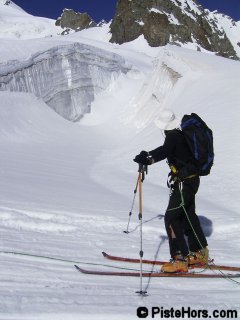
Technique > Glacier Travel for Skiers and Snowboarders > Crevasses
Crevasses are formed on convex slopes where the ice-flow is stretched. During the summer and early in the season many crevasses may be obvious although some others may be poorly bridged. The great French climber, Louis Lachenal was killed falling into a crevasse on the Vallée Blanche while skiing in November.

Seracs
Use of a large scale topographical map and good observation can avoid the worst dangers. Remember that the point where the glacier joins the head of the valley is often marked by a large crevasse called a rimaye or bergschrund (or 'schrund). These are frequently present towards the base of the high couloirs in the alps and are often not clearly visible from above.
Snow bridges should be crossed quickly at the narrowest point of the crevasse by one member of the group at a time. Snow bridges are at their weakest from late morning to late afternoon and in the spring and summer months. Other members of the group should keep the rope taught and anchor themselves well back from the edge. If you feel yourself breaking through the surface try to throw your body towards the nearest bank and spread your arms and legs wide to arrest your fall into the crevasse.
You should carry the following equipment for travel on glaciers:
You may also want to consider having the following items somewhere in your rack:
<< Movement on Glaciers | Glacier Travel for Skiers and Snowboarders | Roping Up >>